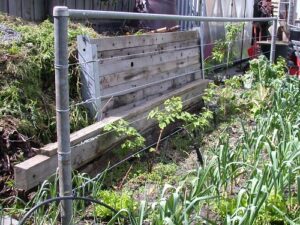Times are changing. We’ve had a warm winter in Central Virginia that has enabled me to continue to pick greens from my fall plantings all season. As noted last month, the VA Cooperative Extension (VCE) has moved Albemarle County into USDA Hardiness Zone 7a, which changes our expected last frost date from mid-May to April 15-25. And, as I write this in mid-March, the long range weather forecast doesn’t anticipate a frost for the next few weeks. The warming trend is real and officially acknowledged. If we gardeners trust it, our planting/harvest season is 2-4 weeks longer than it has been, and it is time to get crops in the ground.
Based on guidance from VCE Publication 426-331, it is safe to plant these cool weather crops now: asparagus, root crops (radishes, beets, carrots turnips etc), cole crops (cauliflower, broccoli, cabbage), greens (chard, collards, kale, spinach, lettuces, mustard), potatoes, and onions (bulb sets, green onions, leeks).
The last week of April is the time to plant beans, cucumbers, eggplant, musk melons (wait until early May for watermelons), pepper and tomato transplants and winter and summer squash).
For more detail, refer directly to Virginia’s Home Garden Vegetable Planting Guide, Publication 426-331.
Tips for best garden productivity include:
- Minimize tilling: The old practice of deep soil tilling is no longer recommended. It damages soil structure, upsets microbial soil life, hastens release of soil carbon into the environment and tends to increase compaction. Better to use a scuffle or stirrup hoe to remove weeds or cover crop residue and only upset the soil surface. Add compost or other amendments to the top couple of inches and let soil critters carry organic matter deeper.
- If compaction is a concern, use a digging fork to loosen the ground. Drive it into the soil as deep as possible and rock it back and forth, every 6-12 inches to loosen soil without destroying structure.
- Remember to rotate crops. Aim to avoid growing the same crop in a given space for a three-year period. It will help reduce insect and disease damage.

- Put up trellises for beans, peas, and cucumbers prior to planting to avoid plant damage later on. For additional information on vertical gardening, see “Intensive Gardening Using Trellises, Stakes and Cages: https://www.pubs.ext.vt.edu/content/dam/pubs_ext_vt_edu/HORT/HORT-189/HORT-189-pdf.pdf.
- It is best to do transplanting on a shady day to reduce shock to tender young plants.
- If transplanting peat pots, tear off the top of the pot to a point below the soil line to avoid wicking water away from plant roots.
- Mulching plants after transplanting or germination is a good thing, but depending on weather, give the soil a chance to warm up before mulching to avoid slowing plant growth.
- When laying out plant locations, remember that leafy greens typically require 6 hours of sun per day while fruiting vegetables want 10 hours.
- Consider intercropping. Mixing different plant varieties uses space well, adds diversity to the garden environment, mixes scents that can confuse pests, and attracts a broader array of beneficial predators, helping reduce pest damage.
- Root crops planted in March should be thinned to about a 3-finger spacing.
- If you would like to extend the harvest season for your greens, consider chard. Chards have a lower tendency to bolt and can withstand summer heat longer than most other greens. In addition, rainbow chard makes a pretty presentation in the garden.
- Should a surprise late frost threaten your warm weather crops, a row cover can save the day. Review the recent Garden Shed article: Row Covers: A Garden Season Extender with Benefits for materials and techniques for their use.

Consider starting an asparagus patch. Asparagus is a perennial that requires a permanent location, full sun and well-drained soil with a pH close to 7.0. Plants can last 15 years or more, so careful location selection is important. Asparagus can be started from seeds or crowns. Crowns are a good idea since it takes a few years for the plants to reach peak harvest potential. For an excellent guide to starting asparagus, read Cleve Campbell’s article “Spear into Spring with Asparagus” in the March 2015 issue of The Garden Shed, and Va. Cooperative Extension Publication No. 426-401, which specifies recommended cultivars for Virginia.
SOURCES:
Cover photo: “Flying Pig Garden” by Harry Wagner is licensed under CC BY-NC-ND 2.0
Trellis photo: “RaspberryTrellis-8896” by graibeard is licensed under CC BY-SA 2.0
Asparagus photo: “Asparagus” by livewombat is licensed under CC BY-NC-SA 2.0